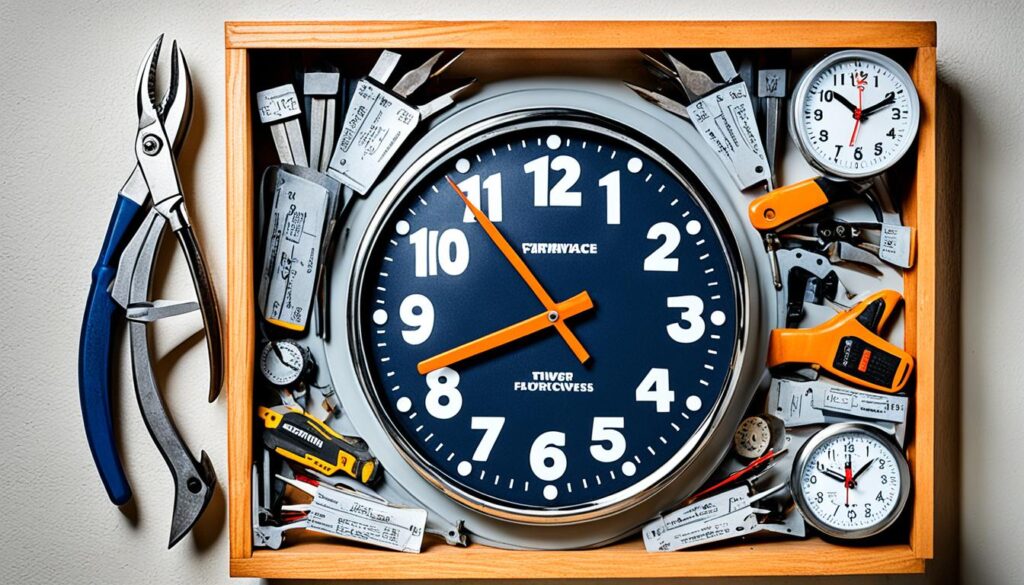Did you know that the average household spends about 45% of its energy budget on heating and cooling? With a significant portion of energy usage allocated to heating, it’s essential to have an efficient furnace installed in your home. But have you ever wondered how long it takes to install a furnace? Let’s explore the typical installation duration and the factors that can influence the timeline.
Key Takeaways:
- The average duration of furnace installation ranges from 4 to 10 hours.
- The type of furnace, complexity of the installation, and size of the building can impact installation time.
- Factors such as accessibility, infrastructure modifications, and unforeseen issues can also affect the timeline.
- Homeowners can ensure a smooth installation by researching reputable HVAC contractors and preparing the installation area.
- Understanding the installation process and discussing specific requirements with the contractor beforehand can contribute to a successful furnace installation.
An Overview of Furnace Installation
Furnace installation is the process of setting up a new furnace or replacing an old one in a residential or commercial building. It involves several essential steps that ensure the efficient operation of the heating system. Whether you’re installing a new furnace or replacing an existing one, understanding the installation process is crucial for a successful project.
When it comes to furnace installation, the first step is to remove the old unit, if applicable. This step is necessary when replacing an existing furnace. Removing the old unit clears the way for the installation of the new one and ensures proper functioning.
After removing the old unit, the next step is to prepare the installation site. This involves evaluating the space requirements, ensuring proper ventilation, and making any necessary adjustments to accommodate the new furnace. It’s important to create a suitable environment for the furnace to operate efficiently.
The next phase of furnace installation involves connecting the necessary components. This includes installing the supply and return ducts, connecting gas and electrical lines (if applicable), and integrating the furnace unit into the heating system. Proper connections are crucial to ensure the safe and efficient operation of the furnace.
Finally, the installation process is completed by testing the system for proper functioning. This involves running the furnace and checking for any issues, such as leaks or malfunctions. Thorough testing ensures that the furnace is working correctly and provides peace of mind to homeowners.
Overall, furnace installation is a complex process that requires attention to detail and expertise. It’s essential to work with a qualified HVAC contractor who can handle the installation professionally. By following the necessary steps and relying on experienced professionals, homeowners can have their new furnace installed or replaced efficiently for optimal comfort and energy efficiency.
Preparation Steps Before Installing a Furnace
Before proceeding with the installation of a new furnace, it is crucial to make several preparations to ensure a smooth and successful process. These pre-installation steps are essential in order to meet the heating needs of the building and ensure the efficient operation of the new furnace.
- Assess the heating needs of the building: Start by evaluating the heating requirements of your home or commercial space. Factors such as the square footage, insulation, and climate will help determine the appropriate furnace size and type for optimal performance. A professional HVAC contractor can provide guidance in this assessment.
- Select an appropriate furnace size and type: Based on the heating needs assessment, choose a furnace that is properly sized and suited to your specific requirements. Consider factors such as energy efficiency ratings, fuel type (gas, electric, or oil), and compatibility with existing HVAC systems. Taking these factors into account will ensure that the installation meets your heating needs effectively.
- Ensure proper ventilation and ductwork: Adequate ventilation and properly sized ductwork are essential for efficient and balanced heating throughout the building. Check your existing ventilation system and ductwork for any necessary repairs or upgrades. It is crucial to have a well-functioning ventilation system to maximize the performance of the new furnace.
- Obtain necessary permits: Depending on local building codes and regulations, permits may be required for furnace installation. Contact your local authorities or consult with an HVAC professional to ensure all necessary permits are obtained before commencing the installation process. This will help avoid any potential regulatory issues or complications.
- Clear the installation area of any obstacles: Prior to the installation, ensure that the designated area is clear of any furniture, appliances, or other items that may obstruct the installation process. Creating a clear and accessible workspace enables the HVAC contractor to work efficiently and ensures the safety of the installation team.
By following these preparation steps, you can ensure that your furnace installation process goes smoothly and that the new system meets your heating needs effectively. Working with a professional HVAC contractor throughout the preparation and installation stages will help ensure a successful and efficient outcome.
Understanding Furnace Types and Installation Complexity
When it comes to furnace installation, it’s essential to understand the different types of furnaces and their installation complexities. The type of furnace you choose can significantly impact the installation process and duration.
There are several furnace types commonly used in residential and commercial settings, including gas, electric, and oil furnaces. Each type has its unique characteristics, installation requirements, and complexities.
Gas furnaces, for instance, rely on natural gas or propane as a fuel source. Installing a gas furnace often involves connecting a gas line to supply the necessary fuel. This process requires knowledge of gas line installation and adherence to safety regulations.
Electric furnaces, on the other hand, rely on electrical energy to generate heat. The installation of an electric furnace may involve special wiring and electrical considerations. An experienced HVAC contractor will ensure the correct voltage and electrical connections are in place for safe and efficient operation.
In some cases, oil furnaces are used, particularly in areas where natural gas or electricity may not be readily available. The installation of an oil furnace involves specific considerations related to fuel storage, fuel line connections, and compliance with local codes and regulations.
Understanding the complexity of each furnace type is crucial for estimating the installation time accurately. By working with knowledgeable professionals, homeowners can ensure a smooth and efficient installation process tailored to the specific furnace type they choose.
The Installation Process: A Step-by-Step Guide
The furnace installation process involves several key steps that ensure a smooth and efficient installation. By following this step-by-step guide, homeowners can gain a better understanding of the furnace installation process.
-
- Step 1: Remove the old furnace (if applicable)
If you are installing a new furnace to replace an existing one, the first step is to remove the old furnace. This may involve disconnecting and disconnecting gas and electrical lines, removing the old unit, and disposing of it properly.
-
- Step 2: Prepare the installation site
Before installing the new furnace, it is essential to prepare the installation site. This includes clearing the area of any obstacles, ensuring proper ventilation, and making sure the space meets the manufacturer’s requirements for installation.
-
- Step 3: Connect the supply and return ducts
The next step is to connect the supply and return ducts to the furnace. These ducts are responsible for distributing warm air throughout the building and returning cold air back to the furnace for heating. It is crucial to ensure a proper seal and connection to prevent air leakage.
-
- Step 4: Install the furnace unit
With the ductwork in place, it is time to install the furnace unit itself. This involves carefully positioning the unit in the designated area, ensuring proper alignment with the ducts, and securing it in place according to the manufacturer’s instructions.
-
- Step 5: Connect gas and electrical lines (if applicable)
If you are installing a gas or electric furnace, this step involves connecting the gas and electrical lines to the unit. It is crucial to follow all safety procedures and guidelines when working with gas and electricity to ensure proper installation and prevent any potential hazards.
-
- Step 6: Perform thorough testing
Once the furnace unit is installed and all connections are made, it is essential to perform thorough testing to ensure proper operation. This includes checking for gas leaks, testing electrical connections, and verifying that the furnace is heating the space effectively.
By following this step-by-step guide, homeowners can ensure a successful and efficient furnace installation process. The next section will explore the average duration of furnace installation and the factors that may affect installation time.
How Many Hours Does it Take to Install a Furnace?
The duration of furnace installation can vary based on multiple factors, including the type of furnace, the complexity of the installation, the size of the building, and the experience and efficiency of the HVAC contractor.
On average, furnace installation can take anywhere from 4 to 10 hours, but this timeframe may extend if additional tasks or complications arise.
In general, the installation process involves several steps, including removing the old furnace (if applicable), preparing the installation site, connecting the supply and return ducts, installing the furnace unit, and connecting gas and electrical lines (if applicable).
The time required for each step may vary depending on the specific circumstances of the installation. For example, installing a furnace in a larger building may take longer due to the additional ductwork and modifications required. Similarly, complex installations involving multiple system components or customizations may require more time and expertise to complete.
It’s important to note that the installation duration can also be influenced by the availability of necessary equipment, permits, and any unforeseen issues that may arise during the process. An experienced HVAC contractor will typically provide an estimated timeframe for completion based on a thorough assessment of the installation requirements and any potential challenges.
To ensure a smooth and efficient installation, homeowners should consult with a reputable HVAC contractor who can accurately assess the installation needs and provide a realistic timeframe. Additionally, homeowners can prepare the installation area in advance by clearing any obstructions and ensuring easy access for the installation team.
By understanding the factors that affect furnace installation time and working closely with a qualified professional, homeowners can better plan for the installation process and minimize any potential disruptions to their daily routines.
Factors That Affect Furnace Installation Time
When it comes to the installation of a furnace, there are several factors that can impact the duration of the process. It’s important to understand these variables as they can affect both the timeline and cost of the installation. By recognizing these factors, homeowners can better anticipate the time required for the installation and plan accordingly.
- Complexity of the HVAC System: The complexity of the heating, ventilation, and air conditioning (HVAC) system plays a crucial role in the installation time. More complex systems, such as those with advanced features or zoning capabilities, may require additional time for proper setup and integration.
- Accessibility of the Installation Site: The accessibility of the installation site also affects the installation time. If the furnace is located in a hard-to-reach area or if there are obstacles hindering the installation process, it may take longer to complete the job.
- Modifications or Upgrades to Existing Infrastructure: In some cases, the installation of a new furnace may require modifications or upgrades to the existing infrastructure. This can include installing new ductwork, upgrading electrical systems, or relocating the furnace. These additional tasks can extend the installation time.
- Presence of Other Tradespeople on-site: If there are other tradespeople working on-site, such as plumbers or electricians, it may affect the furnace installation time. Coordinating with multiple contractors and ensuring everyone’s work is aligned can result in delays if proper coordination is not established.
- Unforeseen Issues: Unforeseen issues can arise during the installation process, such as the discovery of hidden damages or the need for additional repairs. These unexpected complications can prolong the installation time as additional steps or materials may be required to address them.
To better estimate the duration of a furnace installation, homeowners should consult with HVAC professionals who can assess their specific circumstances and provide a more accurate timeline. By considering these factors and working with experienced contractors, homeowners can ensure a successful and timely furnace installation.
Tips for a Smooth and Efficient Furnace Installation
When it comes to installing a new furnace, homeowners can take proactive steps to ensure an efficient and smooth process. By following these tips, you can help facilitate a successful furnace installation:
- Research reputable HVAC contractors: Take the time to thoroughly research and find reputable HVAC contractors in your area. Look for companies with positive reviews, certifications, and experience in efficient furnace installation.
- Obtain multiple quotes: Contact multiple HVAC contractors and request quotes for the installation. This will not only help you compare prices but also gather information about their installation process and timelines.
- Schedule the installation during a convenient time: Consider scheduling the furnace installation during a time when you don’t have any other major commitments or events. This will allow the contractors to focus solely on the installation without interruptions.
- Prepare the installation area: Clear the installation area of any obstacles or belongings that may hinder the installation process. Ensure that there is ample space for the contractors to work efficiently and safely.
- Discuss specific requirements and concerns: Prior to the installation, have an open conversation with the HVAC contractors about any specific requirements or concerns you may have. This will help set clear expectations and address any potential issues beforehand.
By following these tips, you can contribute to an efficient and hassle-free furnace installation experience. Remember, open communication and proper preparation are key to ensuring a smooth installation process.
Conclusion
Installing a furnace is a significant investment that requires careful consideration. Homeowners seeking to install a new furnace or replace an old one may wonder about the duration of the installation process. While the exact timeframe can vary based on several factors, understanding these variables can help homeowners navigate the process more smoothly.
Factors such as the type of furnace, complexity of the installation, size of the building, and the expertise of the HVAC contractor can all influence the installation time. On average, a furnace installation can take anywhere from 4 to 10 hours. However, unforeseen complications or additional tasks may extend this timeframe.
To ensure a successful furnace installation, homeowners should take proactive measures. Researching reputable HVAC contractors, obtaining multiple quotes, scheduling the installation during a convenient time, preparing the installation area, and discussing any specific concerns with the contractor beforehand can all contribute to a smooth and efficient process.
By working with an experienced contractor and following the necessary steps, homeowners can enjoy the benefits of a new furnace efficiently installed in their home. With careful planning and consideration, a furnace installation can pave the way for improved heating and comfort for years to come.





